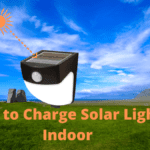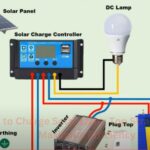How Long for Solar Lights to Charge?
Solar lights typically take 6–8 hours of direct sunlight to fully charge. Solar lights rely on sunlight to charge their batteries, so the duration it takes for them to charge is directly dependent on the amount of sunlight they receive.
On average, solar lights require 6–8 hours of direct sunlight to fully charge their batteries. However, this duration may vary based on factors such as the intensity of the sunlight, weather conditions, and the capacity of the battery in the solar light.
It is advisable to place the solar lights in an area with maximum sunlight exposure to ensure optimal charging. Once fully charged, solar lights can provide illumination for up to 8–10 hours.
How does solar charging work?
When it comes to solar lights, one of the most common questions is how long it takes for them to charge. Understanding how solar charging works can give insight into this matter. Solar charging for lights relies on photovoltaic cells, solar panels, and batteries to harness and store energy from the sun. In this article, we will explore the process of solar charging for lights, including how photovoltaic cells convert sunlight into electricity, the role of solar panels and batteries, and the overall charging process.
How Do Solar Lights Turn On at Night
Photovoltaic Cells convert Sunlight Into Electricity
Photovoltaic cells are the heart of solar charging. These cells are made of semiconductor materials that convert sunlight directly into electricity through the photovoltaic effect. When sunlight hits the cells, the energy knocks electrons loose from their atoms, allowing them to flow freely and generate an electrical current. This electricity is then stored in batteries for later use.
Solar Panels And Batteries
The more sunlight that falls on the panels, the greater the energy production. These solar panels are typically placed strategically to maximize sun exposure and efficiency.
As they store the electricity that the solar panels produce, batteries are essential to solar charging. When sunlight is plentiful, the excess energy is stored in the batteries for use during periods of low sunlight or at night. The size and capacity of the batteries determine how much energy can be stored and the duration for which the solar lights can operate. It is essential to choose batteries with sufficient storage capacity to ensure prolonged illumination.
Process Of Charging Solar Lights
The charging process for solar lights involves several steps that ensure efficient energy capture and storage. Here’s a simplified breakdown:
- During daylight hours, solar panels absorb sunlight and convert it into electrical energy.
- The generated electricity is then sent to the batteries for storage.
- As the solar lights remain exposed to sunlight, the energy stored in the batteries increases.
- Once the sun sets, the solar lights automatically turn on using the stored energy and provide illumination.
- The lights will continue to work until the energy stored in the batteries is depleted or until the sun rises and the charging process begins again.
It is important to keep in mind that several variables, including sunlight intensity, climate, and the caliber of the solar panels and batteries, can affect how long solar lights take to charge and how well they function overall. Optimizing these components can lead to faster charging and longer-lasting illumination.
Factors Affecting Solar Charging Time
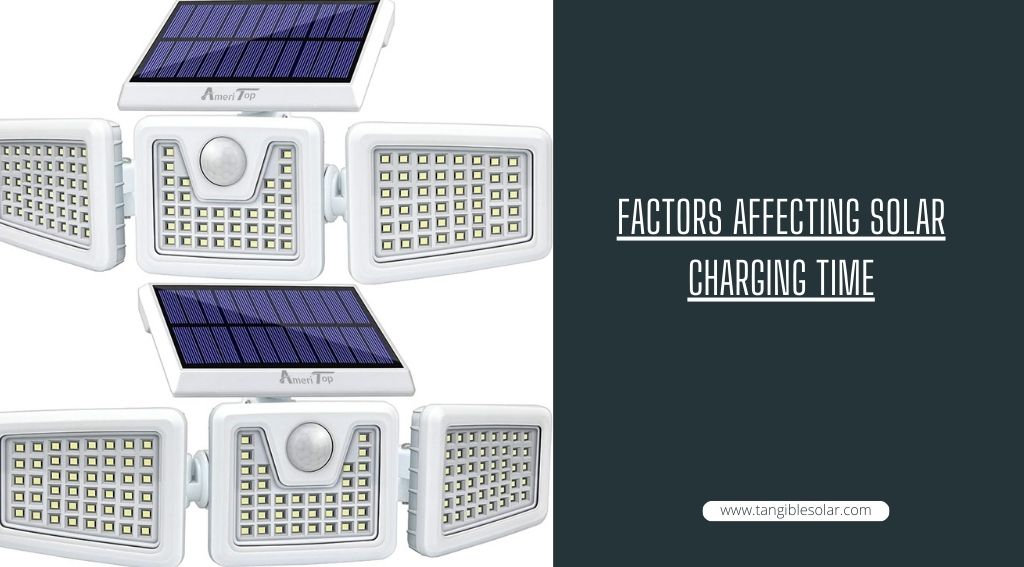
Solar lights are a convenient and eco-friendly way to illuminate your outdoor spaces. However, the charging time of solar lights can vary due to several factors. Understanding these factors can help you optimize your solar lights’ performance and ensure they are fully charged when you need them. Here are the key factors affecting solar charging time:
How to Clean Solar Light Panels
Sunlight Intensity And Duration
The amount and duration of sunlight that your solar lights receive directly impacts their charging time. Solar panels convert sunlight into electricity, so the stronger and longer the sunlight exposure, the faster the charging process will be. Weather conditions, the time of day, and geographic location are just a few variables that can affect sunlight intensity.
Positioning And Angle Of Solar Panels
The positioning and angle of the solar panels installed in your solar lights also play a crucial role in charging time. For optimal performance, it is important to position the solar panels in a location that receives maximum sunlight exposure. Placing them in areas with minimal shading and ensuring they face the sun can significantly improve charging efficiency.
Battery Capacity And Quality
The capacity and quality of the batteries used in solar lights can affect their charging time. Higher-capacity batteries can store more energy, allowing them to charge faster and provide longer illumination. Additionally, using high-quality batteries that are specifically designed for solar applications can optimize charging efficiency and overall performance.
What is solar efficiency?
Solar efficiency refers to the ability of solar lights to convert sunlight into usable energy. It is essentially a measure of how effectively these lights can capture and store sunlight during the day for use during the night. The higher the solar efficiency, the faster the lights can charge and the longer they can stay illuminated after sunset.
Definition And Importance
Solar efficiency is an essential factor to consider when it comes to choosing solar lights that can deliver optimum performance. It is defined as the ratio of the energy output from solar lights to the energy input from the sun. A higher solar efficiency means that the lights can operate more efficiently, making the most of the available sunlight.
The importance of solar efficiency cannot be overstated. It directly impacts how quickly the lights can charge and how long they can illuminate your outdoor space. A higher solar efficiency allows the lights to charge faster, which is particularly beneficial during shorter days or cloudy weather when sunlight may be limited. Additionally, it ensures that the lights remain lit for a longer duration, providing ample illumination throughout the night.
Efficiency Calculations
To determine the solar efficiency of a particular solar light, it is important to consider the energy output and input. The formula for calculating solar efficiency is as follows:
Efficiency = (Energy Output / Energy Input) x 100%
Energy input is the solar energy that the solar lights receive from the sun, whereas energy output is the amount of usable energy that they produce. By calculating this ratio, you can assess the efficiency of the lights and make an informed decision when selecting the most efficient option for your needs.
It is worth noting that solar efficiency can vary depending on various factors, such as the quality of the solar panels used, the angle and orientation of the lights, and the location’s sunlight availability. Therefore, it is recommended to choose solar lights with higher efficiency ratings to ensure optimal performance.
Improving Solar Efficiency
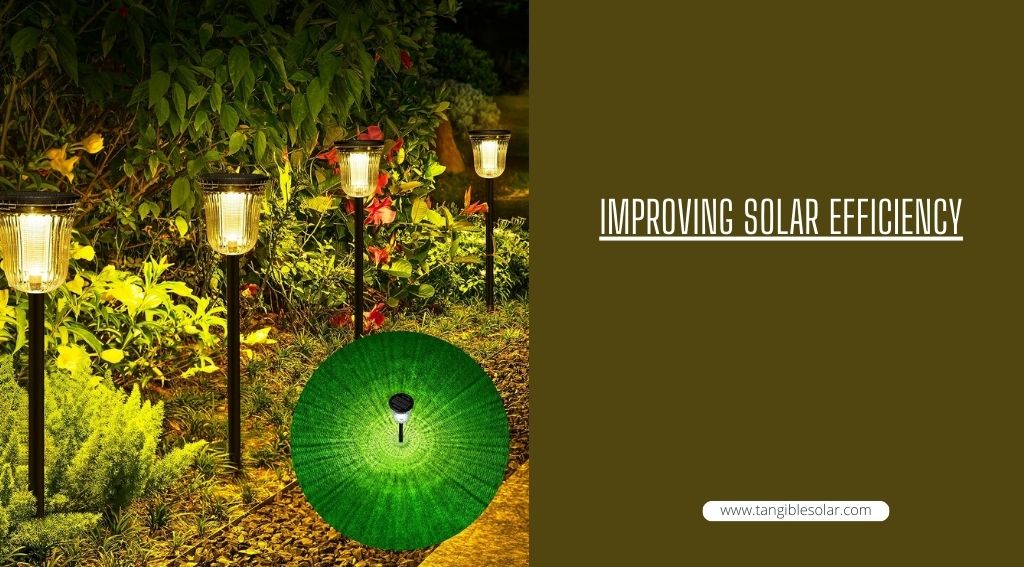
When it comes to solar lights, improving their efficiency is essential to maximizing their charging potential and ensuring they provide consistent illumination throughout the night. By implementing a few strategies, you can optimize the charging process, allowing your solar lights to charge more efficiently and deliver longer-lasting illumination.
Choosing High-quality Solar Panels
One of the key factors in improving solar efficiency is selecting high-quality solar panels. High-quality panels are designed to absorb sunlight effectively and convert it into usable energy. When choosing solar panels for your lights, opt for those that feature advanced technologies such as monocrystalline or polycrystalline cells, as they tend to have higher conversion rates than thin-film solar panels.
Proper Panel Placement And Positioning
The placement and positioning of your solar panels play a crucial role in optimizing solar efficiency. Ensure that the panels are installed in an area where they can receive maximum sunlight exposure throughout the day. Ideally, panels should face the south and have minimal shading from trees or other objects. By positioning the panels correctly, you can capture the maximum amount of sunlight, leading to quicker charging times for your solar lights.
Upgrading Battery Capacity
Another effective strategy to improve solar efficiency is to upgrade the battery capacity of your solar lights. The battery is in charge of storing the energy that the solar panels produce and using it to power the lights at night. By upgrading to batteries with larger capacities, you can store more energy and ensure that your lights stay illuminated for longer periods. Additionally, consider using rechargeable lithium-ion batteries, as they offer better performance and longer lifespans compared to traditional nickel-cadmium batteries.
Estimating Solar Charging Time
A common question when it comes to solar lights is how long it takes to charge them. The charging time can vary depending on different factors, such as battery capacity, solar panel wattage, and sunlight conditions. In this section, we will break down these factors and discuss how they affect the charging time of solar lights.
Determining Battery Capacity
The battery capacity of solar lights plays a crucial role in determining the charging time. It refers to the amount of energy the battery can store and is usually measured in milliampere-hours (mAh). The higher the battery capacity, the longer it will take to charge. To estimate the charging time, you can consider the following:
- Check the battery capacity of your solar lights. This information is usually mentioned in the product specifications.
- Take note of the charging current of the solar lights. It is the rate at which the battery charges and is typically measured in milliamperes (mA).
- Divide the battery capacity by the charging current to get an approximate estimate of the charging time. For example, if the battery capacity is 1000 mAh and the charging current is 100 mA, the charging time will be around 10 hours.
Evaluating Solar Panel Wattage
The wattage of the solar panel directly impacts the charging speed of the solar lights. A higher wattage means more power, which leads to faster charging. To evaluate the solar panel wattage:
- Verify the wattage information mentioned in the product specifications of the solar lights or on the solar panel itself.
- Consider the size of the solar panel as well. Larger solar panels tend to have higher wattage and can collect more sunlight, resulting in quicker charging.
- Compare the wattage with other solar lights or panels to get an idea of its charging efficiency.
Considering Sunlight Factors
Sunlight availability and quality greatly influence the charging time of solar lights. Here are some factors to consider:
- Direct sunlight: Solar lights placed in direct sunlight receive the maximum amount of energy, leading to faster charging.
- Indirect sunlight: If the solar lights are placed in an area with indirect sunlight, such as under a tree or in a shaded spot, the charging time may increase.
- Seasonal variations: Depending on the season, changes in sunlight intensity can also affect the charging time.
It’s important to note that estimating the solar charging time is not an exact science, as it depends on various factors. However, by considering the battery capacity, solar panel wattage, and sunlight factors, you can have a better understanding of how long it may take to charge your solar lights.
Practical Tips For Faster Charging
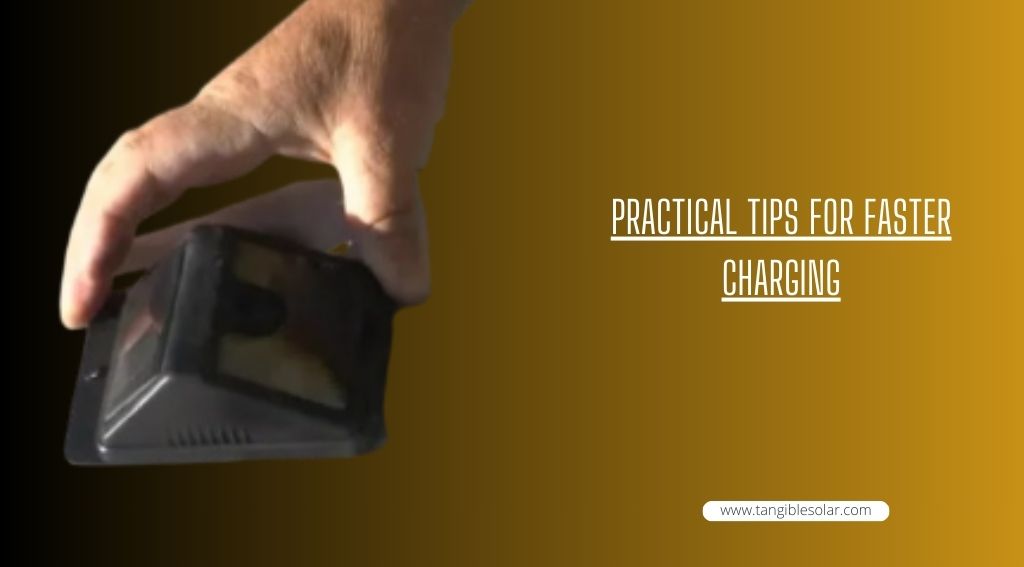
When it comes to solar lights, charging time is a vital aspect to consider. You want your lights to charge quickly so they can illuminate your outdoor space as soon as the sun goes down. In this article, we will discuss some practical tips to help you speed up the charging process and optimize your solar lights’ performance.
Optimal Positioning And Angle
Proper positioning and angle of your solar lights play a crucial role in their charging efficiency. Ideally, the solar panels should receive direct sunlight for the majority of the day. Make sure that no trees, buildings, or other objects that might cast shadows are blocking your lights. Position them in an area that gets maximum sunlight exposure. In addition, consider the tilt angle of the solar panels. Adjust them to face the sun directly for optimal charging.
Regular Panel Cleaning
Clean solar panels are more efficient at converting sunlight into energy. Dust, dirt, and debris can accumulate on the panels over time, reducing their effectiveness. Regularly clean the solar panels to remove any obstructions. Gently wipe them using a soft cloth or sponge with a mild cleaning solution. Avoid using abrasive materials or harsh chemicals that could damage the panels. By keeping the panels clean, you ensure that they can absorb the maximum amount of sunlight and charge your solar lights faster.
Additional Ways To Extend Battery Life
Efficient battery usage can prolong the lighting runtime of your solar lights. Here are some additional tips to extend battery life:
- Use energy-saving LED bulbs that require less power to operate.
- Reduce the brightness level if you don’t require maximum illumination.
- Invest in high-capacity batteries to store more solar energy.
- Switch off the lights when not in use to conserve battery power.
By implementing these measures, you can maximize your solar lights’ battery life and ensure they maintain a charge for longer periods.
Maximizing Lighting Output
When it comes to solar lights, maximizing lighting output is essential to making the most of your outdoor illumination. By selecting the right bulb, adjusting brightness settings, and enhancing light distribution, you can ensure that your solar lights provide optimal brightness and longevity. In this section, we will delve into each aspect to help you achieve the best lighting experience.
Selecting The Right Bulb
Choosing the correct bulb for your solar lights is the first step toward achieving maximum lighting output. Consider the following factors when selecting a bulb:
- The wattage of the bulb
- The color temperature
- The beam angle
- The lifespan of the bulb
Opt for LED bulbs with lower wattage, as they are energy-efficient and can save power for extended illumination. Additionally, bulbs with a higher color temperature (around 5000K–6000K) create a brighter and clearer light. For a wider spread of light, choose bulbs with a larger beam angle. Lastly, check the lifespan of the bulb to ensure it can withstand prolonged outdoor use.
Adjusting Brightness Settings
Most solar lights come with adjustable brightness settings that allow you to modify the output according to your needs. Adjusting the brightness not only affects the illumination level but also influences the charging time required. To maximize lighting output:
- Start by checking the default brightness setting of your solar lights.
- If the default setting is too dim for your liking, increase the brightness gradually until you achieve the desired level.
- Keep in mind that higher brightness settings may require longer charging times to replenish the battery fully.
- Experiment with different brightness levels to strike a balance between the desired illumination and the charging time.
Bear in mind that adjusting the brightness settings according to the time of year and your specific lighting needs can help optimize the lighting output of your solar lights.
Enhancing Light Distribution
Improving the distribution of light from your solar lights can significantly enhance the overall lighting output. Here are a few strategies to achieve better light distribution:
- Position your solar lights strategically in areas where they can receive maximum sunlight during the day, as this helps enhance the charging efficiency.
- Consider angling the lights in such a way that they illuminate the desired areas effectively.
- If using multiple solar lights, space them out evenly to ensure uniform illumination.
- Utilize accessories such as light reflectors or diffusers to amplify and distribute the light more efficiently.
By following these tips, you can utilize the full potential of your solar lights and maximize the lighting output in your outdoor space.
Longevity And Maintenance
Longevity and maintenance are important factors to consider when it comes to solar lights. To ensure the optimum performance and longevity of your solar lights, regular monitoring and maintenance are essential. In this section, we will discuss the importance of monitoring and replacing batteries, protecting solar lights from extreme weather, and establishing a regular cleaning and maintenance routine.
H3 Heading: Monitoring and replacing batteries
Monitoring And Replacing Batteries
One of the key maintenance tasks for solar lights is monitoring and replacing batteries. Solar lights rely on rechargeable batteries to store the energy they collect from the sun. Over time, these batteries may become less efficient and might need replacement to maintain the performance of the solar lights.
To monitor the battery’s life and performance, you can first check the manufacturer’s recommendation for battery replacement. Some solar lights come with built-in indicators that show the battery status, while others may require manual monitoring.
It is advisable to regularly inspect and test the batteries of your solar lights. This can be done by turning the lights on at night and observing their brightness. Dim or inconsistent lighting could indicate a battery issue.
H3 Heading: Protecting solar lights from extreme weather
Protecting Solar Lights From Extreme Weather
Extreme weather conditions can significantly impact the performance and longevity of solar lights. Harsh sunlight, heavy rain, snow, frost, and even strong winds can take a toll on the components of the lights.
To protect your solar lights from extreme weather, consider the following measures:
- Installing solar lights in areas with adequate shade or protection from direct sunlight during the hottest parts of the day can help prevent overheating and prolong battery life.
- During heavy rain or snowfall, providing some shelter or covering for the solar lights can prevent water or ice damage.
- For areas prone to strong winds, securing the solar lights firmly to the ground or using additional supports can help prevent them from being blown over or damaged.
H3 Heading: Regular cleaning and maintenance routine
Regular Cleaning And Maintenance Routine
Regular cleaning and maintenance are essential to keeping your solar lights in optimal condition. Dust, dirt, and debris can accumulate on the solar panels and reduce their efficiency in capturing sunlight.
Creating a simple cleaning routine for your solar lights can go a long way toward maintaining their performance.
- First, make sure to turn off the solar lights before cleaning them.
- Gently wipe the solar panels with a soft, clean cloth or sponge to remove any accumulated dirt or grime. Avoid using abrasive materials that could scratch or damage the panels.
- If there are stubborn stains or residue, you can use a mild dish soap mixed with water to gently clean the panels. Rinse with clean water afterward.
- Inspect other parts of the solar lights, such as the casing, for any signs of damage or wear. Replace any broken or damaged components promptly.
- Reposition the solar lights if necessary to ensure they are receiving the maximum amount of sunlight during the day.
Harness The Power Of Solar Efficiency
As more and more people adopt sustainable practices, harnessing the power of solar efficiency has become a popular choice. Solar lights are a prime example of how we can utilize renewable energy to brighten up our surroundings while minimizing our carbon footprint. In this blog post, we will discuss the process of charging solar lights and shed light on the time it takes for these environmentally friendly devices to charge.
Raising Awareness About Solar Benefits
Solar energy offers numerous benefits to both individuals and the planet. By using solar lights, you are actively contributing to a cleaner and greener world. These lights harness the sun’s energy during the day, storing it in their batteries to provide illumination when the sun sets. By raising awareness about the benefits of solar, you can inspire others to make eco-friendly choices and switch to solar-powered lighting solutions.
Making Eco-friendly Choices
When it comes to making eco-friendly choices, opting for solar lights is an excellent decision. By using the sun’s energy as a source of power, you reduce your reliance on conventional electricity, which is often generated through non-renewable resources. By embracing solar technology, you actively contribute to the reduction of greenhouse gas emissions and help combat climate change.
In addition to their positive environmental impact, solar lights also offer long-term cost savings. Once installed, these lights operate without the need for electricity, saving you money on your utility bills. Moreover, they require minimal maintenance, which further adds to their appeal as a sustainable lighting solution.
Enjoying The Convenience Of Solar Lights
Solar lights are not only environmentally friendly but also highly convenient. Thanks to advances in solar technology, these lights now come in various shapes, sizes, and designs, making it easy to find the perfect fit for your space. Whether you need pathway lighting, garden accents, or security lights, there is a solar-powered option available to suit your needs.
One of the key advantages of solar lights is their ability to operate independently of electrical outlets. This makes them perfect for illuminating areas that are not easily accessible or locations where electrical wiring might be impractical. All you need to do is ensure that the solar panels are positioned to receive direct sunlight, allowing the batteries to charge during the day and provide lighting at night.
The time required for solar lights to charge varies depending on factors such as sunlight intensity, panel size, and battery capacity. On average, it can take anywhere from 6 to 8 hours of direct sunlight to fully charge solar lights. However, it is recommended to consult the manufacturer’s guidelines for specific charging times, as they may vary.
So, if you’re looking to enhance your outdoor space with beautiful illumination while minimizing your impact on the environment, consider investing in solar lights. Not only will you enjoy the convenience of wire-free installation, but you will also contribute to a sustainable future.
Frequently Asked Questions Of How Long For Solar Lights To Charge
How Long Does It Take To Charge Solar Lights For The First Time?
Charge solar lights for the first time for 24 hours to ensure optimal battery performance.
Do solar lights need to be turned on to charge?
No, solar lights do not need to be turned on to charge. They automatically charge during the day through sunlight and store the energy in their built-in batteries. Once it gets dark, the lights will turn on themselves using the stored energy.
How Do You Know When A Solar Light Is Charged?
A solar light is charged when the indicator light turns on or when the solar panel stops flashing.
Can you overcharge solar lights?
No, overcharging solar lights is not recommended, as it can damage the battery and reduce its lifespan.
Conclusion
Solar lights require a sufficient amount of sunlight to fully charge. The charging duration can vary depending on factors such as the size and quality of the solar panel, the weather conditions, and the type of battery used. It is important to position the solar lights in an area that receives direct sunlight throughout the day to ensure optimal charging.
By understanding the charging process and taking proper care of your solar lights, you can enjoy bright and efficient lighting in your outdoor space.

